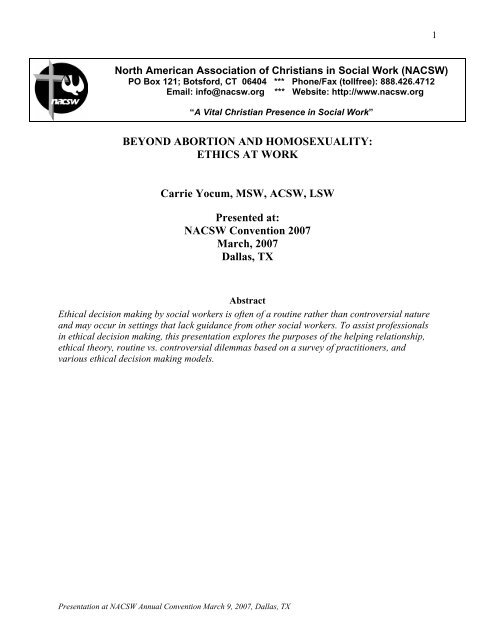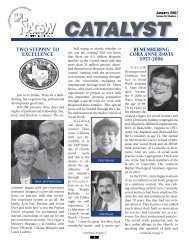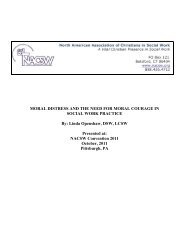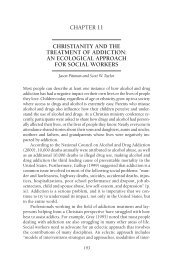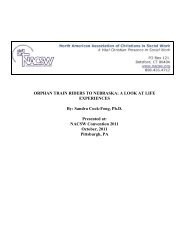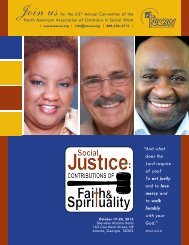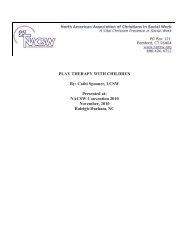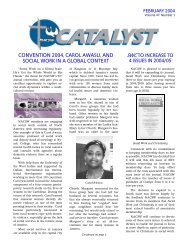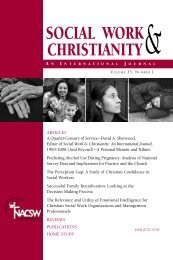BEYOND ABORTION AND HOMOSEXUALITY - North American ...
BEYOND ABORTION AND HOMOSEXUALITY - North American ...
BEYOND ABORTION AND HOMOSEXUALITY - North American ...
Create successful ePaper yourself
Turn your PDF publications into a flip-book with our unique Google optimized e-Paper software.
1<strong>North</strong> <strong>American</strong> Association of Christians in Social Work (NACSW)PO Box 121; Botsford, CT 06404 *** Phone/Fax (tollfree): 888.426.4712Email: info@nacsw.org *** Website: http://www.nacsw.org“A Vital Christian Presence in Social Work”<strong>BEYOND</strong> <strong>ABORTION</strong> <strong>AND</strong> <strong>HOMOSEXUALITY</strong>:ETHICS AT WORKCarrie Yocum, MSW, ACSW, LSWPresented at:NACSW Convention 2007March, 2007Dallas, TXAbstractEthical decision making by social workers is often of a routine rather than controversial natureand may occur in settings that lack guidance from other social workers. To assist professionalsin ethical decision making, this presentation explores the purposes of the helping relationship,ethical theory, routine vs. controversial dilemmas based on a survey of practitioners, andvarious ethical decision making models.Presentation at NACSW Annual Convention March 9, 2007, Dallas, TX
Beyond Abortion2IntroductionAs a social work educator, I regularly encounter issues associated with ethical dilemmas, both inandoutside the classroom. Some are associated with my role as an educator such as when to treat“like things alike” and when to treat “unalike things unalike” in subjective situations such asstudents’ dispositions, efforts, and developmental needs. Sometimes the dilemmas are related tomy role as a social worker, such as how confidentiality is carried out in an academic contextrelated to student development and campus life. Sometimes dilemmas are related to my role as awoman in a conservative, Christian context, such as the leadership positions of women on ourcampus.Regardless of the context, the tension I face when presented with equally undesirable optionswhile needing to determine the best course of action remains high. In these situations, I desire todo “the right thing right the first time,” yet am very aware that others’ view of the “right thing”may differ sharply from my own.As an adult, I face these issues more than I expected to as a college student. Perhaps naïve,perhaps under-prepared, perhaps simply unaware, it never occurred to me as an undergraduatestudent that decision making in social work practice could be of an ethical nature and not directlyinvolve my client- or any identified client for that matter. It is this reality that I try to convey tostudents in my teaching.Fortunately, our undergraduate social work program’s curriculum design enables me to bothintegrate content about ethics throughout each of my courses and teach a discrete EthicalDecision Making for Helping Professionals course. It is through these experiences that I haveencountered many student concerns and reactions to the issue of professional ethics. It is notuncommon for students to simply assume, for example, that all professionals who work in socialservices will get along, share their same motivation for helping and service, exhibit their samelevel of genuineness and professionalism, always desire to put clients’ needs above their own,and have all the resources they need to provide for everyone’s needs.Unfortunately, we know this is not always the case. Students, field interns, and even practicingprofessionals find themselves in situations requiring difficult decision making, often of an ethicalnature. Because of their inexperience, however, students often cannot conceive of these types ofdecisions and instead focus on decision making of considerable moral importance to them.Though these are clearly issues worthy of discussion, I suggest that concerns about thesediscussions are disproportionate to the more routine difficult decisions that social workprofessionals face on a much more regular basis.Thus, in an effort to highlight the broad nature of ethical decision making, it is the purpose ofthis paper to define the nature and purpose of the professional helping relationship and reviewbasic ethic and social justice theories as foundational to ethical decision making. Additionally,this paper reports the results of my informal, exploratory ethical decision making survey andbriefly reviews of ethical decision making models.Presentation at NACSW Annual Convention March 9, 2007, Dallas, TX
Beyond Abortion3Purposes of the Professional Helping RelationshipAccording to the National Association of Social Workers (NASW) Code of Ethics (1996),professional ethics are at the core of social work. Consequently, the profession has an obligationto articulate its basic values, ethical principles, and ethical standards. The NASW Code of Ethicssets forth these values, principles, and standards to guide social workers’ conduct. While theCode is relevant to all social workers and social work students, regardless of their professionalfunctions, the settings in which they work, or the populations they serve, it only applies tomembers of NASW.The NASW Code of Ethics serves six purposes:1. The Code identifies core values on which social work’s mission is based.2. The Code summarizes broad ethical principles that reflect the profession’s core valuesand establishes a set of specific ethical standards that should be used to guide social workpractice.3. The Code is designed to help social workers identify relevant considerations whenprofessional obligations conflict or ethical uncertainties arise.4. The Code provides ethical standards to which the general public can hold the social workprofession accountable.5. The Code socializes practitioners new to the field to social work’s mission, values,ethical principles, and ethical standards.6. The Code articulates standards that the social work profession itself can use to assesswhether social workers have engaged in unethical conduct. NASW has formal proceduresto adjudicate ethics complaints filed against its members. In subscribing to this Code,social workers are required to cooperate in its implementation, participate in NASWadjudication proceedings, and abide by any NASW disciplinary rulings or sanctionsbased on it.It is through these purposes of professional accountability to the public, guidance in decisionmaking, professional self-regulation, standards of interaction, protection, and guidance andsocialization to the profession that social workers can ethically engage in a professional helpingrelationship (Congress,1999). The specific nature of the helping relationship, however, should beclarified in order to understand ethical practice.In defining the professional helping relationship, Parsons notes that “unlike most socialexchanges, primacy [in the relationship] is given to one member, the client,” (2001, p. 6).Whether an individual, family or an entire community, it is the client’s concerns, needs, goals,and welfare that motivate, influence, and shape the social worker’s decision making (Parsons,2001). While they are friendly, social workers do not develop friendships with their clients; therelationship is “deliberate and professional” (Miley, O’Melia & DuBois, 1998, p. 122).Further, unlike other social encounters that are open-ended and remain so as long as both parties’needs are being met (like friendships and casual relationships), the helping relationship isdesigned to achieve some specific purpose and terminate with the achievement of that goal(Miley, O’Melia & DuBois, 1998; Parson, 2001). Once the goal (or “defined ending”) in thePresentation at NACSW Annual Convention March 9, 2007, Dallas, TX
Beyond Abortion4helping relationship is attained, the need for the helping relationship no longer exists (Miley,O’Melia & DuBois, 1998, p. 122).Additionally, the nature of the helping relationship, while reciprocal, is not personally so. Bothparties do not disclose equally; in fact, for the social worker to do so might be unethical itself.The professional helping relationship has a designated purpose, so when the needs, wants, andconcerns of the social work take focus at the expense of the client, the potential for unethicalbehavior increases (Miley, O’Melia & DuBois, 1998; Parsons, 2001). While both the socialworker and the client have roles and responsibilities in the professional helping relationship, it isthe social worker’s responsibility to define and maintain the helping relationship, facilitate thedevelopment of a working relationship with the client, and bring special knowledge and skill tothe relationship so, when applied, they assist the client’s movement toward a specific outcome(Parsons, 2001).While ethical dilemmas may surface at any time during the helping relationship, including thosewhen the social worker is assisting the client in clarifying life-enhancing goals, they may alsooccur at times when social workers are fulfilling their own professional responsibilities. Thoughsocial workers seek to enhance the well-being of all people, according to the profession’smission they give particular attention to those who are vulnerable, oppressed, and living inpoverty. This sensitivity toward oppression means that social workers encounter the mostvulnerable in our society, thus heightening their ethical responsibility to guard against furthermarginalization in the service delivery system.Basic Concepts of Ethical and Social Justice TheoriesWhen faced with ethical this ethical responsibility, social workers may consider variousapproaches when considering ethical dilemmas, value tensions, and difficult decision making.Dolgoff, Loewenberg and Harrington (2005) note several approaches that social workers havefound helpful in making ethical decisions including clinical pragmatism, humanistic ethics,situational ethics, religious ethics, and feminist ethics. Religious ethics, in particular, are ofprimary importance to believers who practice the profession of social work in that “they cannotconceive of the long-term effectiveness of ethical principles that come from a source other thanthe divine will” (p. 50).While it is beyond the scope of this paper to address these various approaches to decisionmaking, they are worth mentioning to those interested in further reading. Perhaps foundational tothese contemporary approaches, however, is normative ethics: the category of philosophyconcerned with how people ought to act and with classifying those actions as either right orwrong. Normative ethics is comprised of three broad categories: virtue ethics, consequentialism(and its sub-category of teleological thought), and deontology described briefly below.Virtue EthicsMeara, Schmidt and Day (1996) suggested that while formal conversations about the standardsof professional behavior have had a long history, the “conceptualization of principle ethics fordecision making” in professions such as counseling and medicine was “void in conversations”about virtue ethics (p. 4-5). Principle ethics, as they define them, are a “set of prima facieobligations one considers when confronted with an ethical dilemma” (p. 4). Meara and associatesPresentation at NACSW Annual Convention March 9, 2007, Dallas, TX
Beyond Abortion6Deontological ThoughtIn contrast to teleological thought is deontology, which proposes that actions themselves can bedetermined good or bad, right or wrong, based on fixed moral rules rather than theirconsequences (Reamer, 1999). These fixed rules, rights and principals are intrinsically right andguide decision making in that they are followed in all situations regardless of circumstances(Dolgoff, Loewenberg & Harrington, 2005; Meara, Schmidt & Day, 1996). One’s duties and therights of others guide decision making. Consequently, an individual’s behavior can be wrongeven if it produces a good outcome. Alternatively, an act can maximize good but still be wrong ifit violated human freedom and rationality: claiming, for example, “at least implicitly, it isacceptable to violate the law when it appears that a greater good would result” (Reamer, 1999, p.68).Similar to a feminist perspective that values networks of care and networks of relationships(Dolgoff, Loewenberg & Harrington, 2005), a deontological course of action is more concernedwith how someone makes a decision rather than what the outcome is.German philosopher Immanual Kant is typically associated with deontological thought as areJohn Rawls and John Locke.Other Aspects of Social Justice TheoryOther concepts related to social justice, and ultimately ethical decision making, are discussed atlength by Robison and Reeser (2000, Chapter 6) and summarized below.1. Formal principles of justice: This involves treating like cases alike and unalike casesdifferently. While on the surface, this seems logical, it may be difficult to apply depending onthe situation. For example, to someone with a racist point of view treating all people with oneskin color differently than those of another skin color satisfies the formal principle of justice.This formal principle requires consideration of the fact that individual practice createsprecedents.2. Substantive principles of justice: This concept adds to the formal principle of justice thequestion of which cases are alike and which are different. Adding this principle helps with,but will not always resolve, the formal principle of justice. It requires asking what the rightdecision is in relevantly similar cases. Granting an exception to one client who does not haveto list all his/her resources means considering what happened with similar cases in the pastand what might happen in future cases. The substantive principle of justice asks questionssuch as “What is being distributed?” “Who is getting what?” and “What are the reasons fortreating groups of people differently?”3. Procedural justice: These are the steps to effectively get what you want. Ultimately,procedures are imperfect and some who need services do not get them, while others who donot need services receive them. To make an ethically proper argument about a system,however, there needs to be an examination of the relevant percentages. For example, of allthose who need help, how many do not obtain it, and of those who do not, how many doobtain it? Determining this means that we can proceed to object to the procedure, thoughpeople will always disagree about how much is “too large.”Presentation at NACSW Annual Convention March 9, 2007, Dallas, TX
Beyond Abortion8completing the survey anonymously. Many included their names and all but one returned thesurvey via email, thus identifying themselves.FindingsThe primary field of practice reported by most participants was mental health, though it wasfollowed closely by child and family welfare.Table 1 Current, Primary Field of PracticeField of Practice N*Mental Health 6Child and Family Welfare 5Aging 2Disabilities 1School/education 1Other: Death and dying 1Long-term care 1Low-income households 1Intern in addictions 1Total 19Note. Total respondents = 17. One participant noted both employment and MSW internship fields of practice and asecond participant reported two fields of practiceClarification in future research might include whether participants were employed in a faithbasedsetting, thus suggesting the presence of dilemmas that may be divergent than some foundin non-faith-based settings.Participants’ reported tenure in their field of practice ranged from 3 months to more than 28years, with an average of 5 years and 9 months. The length of time in practice is likely areflection of the greater number of program graduates who responded than seasonedprofessionals.Table 2 Length of time in this field of practiceAverage Maximum Minimum Median5.9 years* 28 years, 4 months* 3 months 3 years, 6 monthsNote. One respondent reported “20+ years.” The average and median were determined using 20 years.Further research might include years of post-degree experience, which may enable crosstabulationof data related to length of time in practice and methods of resolving ethical dilemmas.Presentation at NACSW Annual Convention March 9, 2007, Dallas, TX
Beyond Abortion9Most participants reported having an undergraduate social work degree, followed by a Master ofSocial Work degree. These responses are generally representational of the population receivingthe survey. Participants could report more than one degree, such as a BSW and an MSW.Table 3 Degrees HeldDegree N*MSW 6MA or MS 0BSW or BA/BS with major in social work 12No college degree 0Other: Last semester of MSW 1Total 19Note. Total participants was 17; however, two reported both BSW and MSW degrees.About half the participants reported daily contact with either a BSW or an MSW colleague;however, many also reported only weekly, monthly or no contact at all.Table 4 Frequency of Contact with Social Worker by Degree in Current WorkplaceFrequency of Contact BSW Degree MSW Degree*Never 2 4Daily 8 8Weekly 1 2Monthly 2 2Only when I request it 0 1No answer 4 0Total 17 17Note. *One respondent reported “nearly daily in my first job (3 months); rarely in the second (2 months).Further research might focus on the availability of social work-degreed colleagues forconsultation and resolution of ethical dilemmas and conflicts by field of practice.Most participants, 69%, reported referring to the NASW Code of Ethics (1996) infrequently. Thereasons for such infrequent reference to the Code of Ethics cannot be determined based on thenature of the survey.Presentation at NACSW Annual Convention March 9, 2007, Dallas, TX
Beyond Abortion10Table 5 Frequency of Reference to Code of Ethics in Own PracticeFrequency0-2 times per month 123-5 times per month 46-8 times per month 19 or more times per month 0Total 17Further research may investigate the reasons participants cite for their infrequent reference to theCode of EthicsAs expected, the majority of participants (81%) reported that there was no ethics committee intheir agency setting.NTable 6 Presence of Ethics Committee in Agency SettingEthics CommitteeYes 3*No 14Total 17Note. *One respondent new on the job was not sure. The researcher is familiar with the agency. It does have aHuman Rights Committee.While an ethics committee could serve as a useful vehicle for addressing ethical dilemmas in anagency setting, many survey participants worked in smaller agency settings in which an ethicscommittee would be unlikely given the agency’s resources and structure.Of the three participants reporting the presence of either an ethics or human rights committee intheir agency setting, only one reported the appointment of a degreed social worker to thatcommittee.NTable 7 BSW or MSW Appointed to Agency Ethics CommitteeBSW or MSW AppointedYes 1No 1Unsure 1*Total 3Note.*The respondent who was “unsure” but reported “yes” in Table 6 reported “unsure” in Table 7. The researcheris familiar with the agency. There is no social worker appointed to its Human Rights Committee.NPresentation at NACSW Annual Convention March 9, 2007, Dallas, TX
Beyond Abortion11Most participants reported that when faced with an ethical dilemma their first course of actionwas either to talk their agency supervisor or talk with a BSW or MSW colleague in the agency.Consistent with responses reported in Table 5, none reported their first action as referencing theNASW Code of Ethics (1996).Table 8 Typical First Action to Resolve an Ethical DilemmaFirst ActionTalk to my agency supervisor 8Talk to a BSW or MSW colleague within the agency 6Talk to a professional (non-BSW/MSW) colleague in the agency 2Talk to a professional (non-BSW/MSW) colleague outside the agency 1Read the agency’s policies and procedures 1Contact the NASW ethics call line or consultant 1Contact legal counsel 0Read the NASW Code of Ethics 0Talk to a BSW or MSW colleague outside the agency 0Other: Contact MSW classmates & graduate school professors 1Total 20*Note.*One participant reported three (3) first actions and another respondent reported two (2) first actions.Future research might include clarification as to whether the agency supervisor possessed a BSWor MSW degree to distinguish that first action from other options.More than half the survey participants (69%) reported working with professionals from otherdisciplines who appeared to resolve ethical dilemmas differently than the participant did.NTable 9 Present Work with Professionals from Other Disciplines who Resolve Dilemmas DifferentlyOther Professionals Resolving Dilemmas DifferentlyYes 12No 5Total 17While the disciplines that might be considered “other” by the participants cannot be determined(see Table 10), interestingly, those that participants did cite could all be considered professionaldegrees, thus seemingly providing those professionals with both educational and professionalstandards of ethical practice.NPresentation at NACSW Annual Convention March 9, 2007, Dallas, TX
Beyond Abortion12Table 10 Professional Differences in Ethical Decision MakingProfessionNNurse 3Doctor 2Teacher 2Attorney 1Clergy 1Other non-degreed workers providing social services 1Other professionals/disciplines 5Total 15These types of professionals appear to reflect those expected in the fields of practice thatparticipants reported in Table 1.Participants noted a variety of differences in professional decision making in their fields ofpractice. I categorized these examples very generally as differences related to clinical or directpractice, legal issues, use of codes of ethics, personal characteristics of the professional, and useof consultation. I did not provide prompts in the survey regarding the types or details of decisionmaking used by other professionals.Table 11 Categories and Examples of Differences in Decision Making PracticesCategories of DifferencesClinical or direct practiceLegalCode of EthicsExamples of DifferencesBoundaries, termination, abandonment of clientsSelf-determinationLack of multi-dimensional approach as in social workLess sensitivity to client’s perspectiveResolution through medication and treatment vs. changing behaviorsDo not understand dual relationshipsThey seem to be “free with information”“A lot of times children get a label, and there is no need for a label, withouttaking into consideration the family’s dynamics”“They affect the way I do my job”“Most medical staff still tend to think in a medical model versus social model.This can lead to disagreements in completing ethical decisions.”When there is involvement with an attorney and/or plea agreements, the delay orprohibition of treatmentSome other professionals do not understand “duty to report law”Difficulty understanding the importance and necessity of HIPPAAmbiguity regarding best approachDoing what they “feel” to be the correct thingEthical standards seem to be “union rules”Presentation at NACSW Annual Convention March 9, 2007, Dallas, TX
Beyond Abortion13Categories of DifferencesPersonal characteristicsConsultationExamples of DifferencesLack of understanding about what ethical dilemmas are (e.g., limits or conceptof confidentiality)Lack of understanding about solving ethical dilemmasUtilize a “less formal” method of decision making; no evidence of a formalprocess“Many . . . I interact with are a generation older than me”“At times they can come across as knowing everything and should not bequestioned when they ask for something”“Especially those who have worked in the field for several years”Consulting colleagues vs. a code of ethics“They do not have people to talk with’“I’m not aware of any group they can contact when they have questions”“Solve things according to test scores and what a psychologist has to say”Staff a case, talk through the factors, decide as a group what the best decisionwould be. At times it is a group consensus, but at others the decision is madeinformally by rank of the “opinion-giver”Some participants noted no discernable differences between their own decision making and thatof their colleagues in other disciplines. Future research might investigate the similarities anddifferences between these social workers and their colleagues.One of the primary purposes of this exploratory survey was to clarify whether controversialsocial issues occurred as frequently in social work practice as students sometimes fear. Inquestion ten on the survey, I provided the following context to participants regardingcontroversial social issues:Many social workers with a faith-perspective, particularly those with moreconservative and/or evangelical Christian perspectives, fear having to condoneor support their clients’ request for help with choices in life that might beconsidered at odds with a conservative, evangelical Christian worldview (e.g.,abortion, assisted suicide, homosexuality, pre-marital sex). Often discussionsabout ethical decisions focus on these “major or controversial social issues."(See Appendix 1, survey)Following the contextual information provided above, I then asked participants the following:Question: In your recollection, regardless of whether you identify yourself as anevangelical or conservative Christian, how often would you estimate that youhave encountered requests by a client related to a “major or controversial socialissue” in your practice? Please feel welcome to provide examples and discussionto help clarify. (see Appendix 1, survey)Participants in this survey were asked to estimate the frequency with which they encounteredclient requests related to “major or controversial social issues.” Three participates indicated thatPresentation at NACSW Annual Convention March 9, 2007, Dallas, TX
Beyond Abortion14they often had requests such as these, which was likely a function of their work in residentialsettings, two with adolescents and one with adults with developmental disabilities.Table 12 Frequency of Encounters with a “Controversial Social Issue”Response N Estimation and ExamplesYes 3 “often”- homosexuality or “identity testing”“30% of our cases”- homosexuality, pre-marital sex, pregnancy“about once a month”- sex during dating between those withdevelopmental disabilitiesSeldom 5 previous employment- abortion, also racism, pedophilia“maybe 2 times per year”- sexual orientation, premarital sex“few occasions”- passive suicide through refusal of food or medication“not many requests”“not often”No 6 “I’m not in a position where I am asked to assist with something such asan abortion. My clients normally tell me about the choices they aremaking, and I tell them my thoughts on the issue. . . in conjunction withcommon sense and research”Co-worker 1 homosexualityTotal 15*Note.*Some participants included more than one response and some did not answer. Some did not specificallyanswer the question.Further, one participant noted that while there was consensus amongst the social workers in heragency “regarding addressing behaviors (just as we do heterosexual), sometimes we are viewedas ‘liberal’ [by others in the agency] if we uphold ‘self-determination’ and do not overtly(consequence) homosexual statements, etc.”Another participant commented in response to Question 10 that “not all social workers areChristians nor are all participants of this survey. Therefore I have difficulty in answering yourquestion.” While the intention of the question was to inquire about the presence of “major orcontroversial social issues” rather than the participant’s Christian worldview, future researchmight include clarification of the question.Because prompts were provided for Question 10 (see the contextual statement noted previously),it is likely that participants may not have considered situations beyond those provided, whichfocused on sexuality and preservation of life issues. One participant made reference to racismand pedophilia, but did not elaborate as to meaning or provide specific examples. Future researchmight evaluate the advantages and disadvantage of prompts such that open-ended questionsmight yield “controversial” issues others than these. Clarification of the term “controversial”might also be useful.Presentation at NACSW Annual Convention March 9, 2007, Dallas, TX
Beyond Abortion15Additional research might consider further demographical information to include theparticipants’ self-described worldview (Christian or otherwise). This might yield differences inthe distinction between controversial issues and those of a routine nature.Finally, participants were asked in Question 11 to provide examples of the more routine yetdifficult decisions they might have to make in their field of practice. The following context andprompts were provided:Often in our practice, rather than encountering “major or controversial socialissues” that require our response, we instead encounter more routine ethicaldecisions when faced with equally undesirable choices or contradictory ethicaldirectives.Question: What types of more routine ethical decision making or ethical conflictshave you encountered in carrying out your responsibilities at work? The morespecific or detailed you can be the better. You might want to consider issuesrelated to:• boundaries and dual relationships (e.g., dating a supervisor or colleague, socializing withstudents you supervise, attending the birthday part or wedding of a client, attending churchor Sunday School with someone receiving services from your agency)• accountability (e.g., related to funding, documentation), or reimbursement)• resource allocation (e.g., time, money, space, appointments; assistance based ondiagnosis, etc.)• research (e.g., data collection methods such as for client satisfaction; informed consent;the accuracy or type of “evidence” or statistics to include in a grant proposal)• confidentiality and privacy (e.g., privacy associated with group work, family work, or taskgroups; unsafe health practice by those with communicable diseases; issues dealing withminors; when do you have enough “suspicion” to make a CPS or APS report?)• competence (e.g., new workers’ autonomy vs. inexperience and minimal supervision,referral vs. client self-determination, impairment or unethical practice of a colleague).(see Appendix 1, survey)While the participants were not limited to these categories of decision making, most respondeddirectly to these prompts. Additionally, there were some responses that I categorized as beingrelated to client safety and well-being and legal vs. practice decisions.Table 13 Examples of Routine Ethical Decision Making or ConflictsCategories ofDecision MakingAccountabilityExamples of Ethical Conflict in the WorkplaceAccount for hours worked, mileage driven, scheduling appointments“Specifically with time”“It seemed like some of what we counted as billable was a stretch”“At times, employees may do something for patients ‘on their own time’.”How easily notes can be back dated when behind in documentationBilling decisions for optimal reimbursement ratesPresentation at NACSW Annual Convention March 9, 2007, Dallas, TX
Beyond Abortion16Categories ofDecision MakingBoundaries, DualRelationships, Conflictsof InterestResource AllocationExamples of Ethical Conflict in the WorkplaceBilling for emergencies within the limits of the payor“I have a quota that I must obtain each month which is very difficult to achieve. . . . There isan incentive of $100 at the end of the month if we achieve this goal. This calculates out toabout 5 hours a day. When I first got my job, other case managers told me to fudge my hoursbecause there is no way I will be able to get those hours.”“I’ve been working at the same agency for five years and just this year we are finallydocumenting and keeping accurate account of finances. . . . Money was not being spent oraccounted for the way it should have been. Most of the problems can be traced back to acorrupt Executive Director that was here for six years and it took this long to untangleeverything . . .”“My personal values came in conflict with the issue of dual relationships and giving a Bibleto the student [client] could be considered a violation of agency policy.”“Especially troubled teenagers who latch on to anyone”“Employees of this agency who are in supervisory positions deciding to be foster parents andthen having another employee from the agency as their social worker.”Being friends with a supervisor then colleagues discussing employee “favorites”Being overly friendly with a resident/family member (e.g., “give me a ride on your lap” tosomeone in a wheelchair)Lack of management action regarding a colleague’s engaging in an affair with a [long-termcare] resident’s husband and subsequently becoming pregnantReferrals from the minister at the social worker’s churchEncountering clients in the communityBeing asked at church if the social worker knows someone seen receiving servicesThe ethics of psychotherapy with more than one family memberFamily members wanting to provide information to the worker without the worker’sdisclosing it to the clientTaking on the “parent” role with child clients rather than clarifying “the therapeuticrelationship”Setting limits to the amount of interaction between clients/families and employees.Residential staff developing very close relationships with the residents that continue after aresident has graduated or left the program.“For two years my roommate was also one of the people I supervised . . . Our housing waspaid for by the agency we worked for so we were placed together. . . . At times I felt like Iwas always working no matter if I was in my office or in my apartment. . . . Suddenly Iturned into her boss and was giving her training on how to do her job better. Also, I could notcome home and vent . . . because it would be unprofessional and cross the dual relationshipline.”Socialization between management and reporting staff as well as students, often not incompliance with company policy and ending poorly.“We always seem to have money for more marketing, buildings, etc. but have to fight forprogramming dollars”“At what point do I put a request to the side because there are likely not enough resources toserve them?”Nursing staff requesting that someone be “terminal” thus shifting the care from nursing toaidesPresentation at NACSW Annual Convention March 9, 2007, Dallas, TX
Beyond Abortion17Categories ofDecision MakingResearchConfidentialityColleague Relationshipsand CompetenceClient self-determinationwell-being, and safetyLegal vs. practicedecisionExamples of Ethical Conflict in the Workplace“Again, before this year, our agency was not paying anyone overtime or ‘sleep’ time . . . Itwas a serious ethical conflict for me because not only was I both working overtime and doingnight shifts without getting paid for them, but I was supervising those who were.”“There is a conflict of interest when I am ‘interpreting’ for the resident with speechimpediments who is talking [to the agency conducting life quality assessments] about howhe/she feels about the supports I am giving him/her.”Weighing against “the community’s and funder’s requests for information to gain approvalfor funding or for reports. Also, reacting to the community’s and funder’s priorities ratherthan what we, on the front lines, see as more vital issues.”“What is said to clients . . . is not exactly reality. Co-workers are more aware of otherworker’s client’s situations than clients are led to believe I think”“How much to tell the school—[adolescent sexual offenders’] issues have the right to beconfidential, but the school also is responsible for providing supervision and making sureother students are safe.”Indirectly communicating to visitors and others the diagnosis of a patient through location ofsupplies or signageFamily members’ requests for information regarding a minor or legal adultAcceptable breaches for protection: legal protection of a minor for substance abuse treatmenteven if it is different than the referral problemWhether adults can cancel and re-schedule another legal adult’s appointment without aconsentWhen writing progress reports, protecting the “confidentiality of the other parties involved inspecific conflicts, etc. but it is sometimes difficult to do so because we all live in the samecommunity and know each other.”The issue of confidentiality in health care, which “can apply to both patients and staff”When to speak up to co-workers who are not social workersHiring or delegating to those without training or experience for cost-effectiveness“Sometimes because we are a Christian agency we hire people who are good people but don’thave any social work related degrees.”Lack of competence (i.e., work ethic) in seasoned colleagues“Workers are trained based on a quarterly training schedule, but seem to sometimes lack thebasic skills to truly provide a therapeutic environment. Workers, such as myself, who areinexperienced are given minimal supervision and at times placed in situations they are not yetcompetent to handle.”Supervision and directives to workers “without regard to client self-determination.”“Direct care staff frequently make decisions that I feel violate the client’s right be free fromharm. The staff perform some restraints incorrectly or inappropriately.”“Making sure that every patient we care for is safe in his or her home, with a competentcaregiver can be a challenge at times” (NOTE: participant categorized as confidentiality andprivacy)“I also deal with the tension between making a CPS report based on accusations from childclients and recognizing frequent lying by client.”“The other issue that arises is that at times you get into legal opinions and getting attorneys toagree on things can be difficult.”Presentation at NACSW Annual Convention March 9, 2007, Dallas, TX
Beyond Abortion18The participants’ responses demonstrate a range of difficult decisions encountered in theirworkplaces. Some might be better categorized as practice decisions rather than ethical dilemmas,and some would clearly violate an agency, state, or federal policy should the worker act on it.The purpose of the survey, however, was to highlight the nature of the difficult, routine decisionsthat workers are faced with and the domains in which those decisions fall. These responseshighlight those, particularly those decisions or dilemmas that may be faced by new,inexperienced, or under-socialized social workers.SummaryThere are multiple limits to this exploratory survey, which in turn limit the validity of anyconclusions I might draw. The purpose of the survey, however, was to explore the nature ofdilemmas and difficult decision making encountered on a routine basis by social workers.Further, it was to explore the availability of other social work colleagues and ethics committeesto the social worker responding.Ultimately, the participants were able to identify a variety of dilemmas and difficult decisions ina variety of categories. It is possible that the prompts I provided limited their responses and that,had I not done so, the participants on their own may have identified other categories or examplesof dilemmas.Participants also noted that, at least in their practice settings, ethics committees are not common(n=3 or 18%) and in only one setting was a social worker appointed to the ethics committee.While “routine” ethical decision making may not be automatically referred to an ethicscommittee, it does not appear that a committee convened for purposes of resolving ethicaldilemmas is an available option to many social workers who may need assistance beyond thatwhich a colleague, supervisor, or code of ethics can provide.The participants’ responses also reflect the various conflicts that workers may experience eachday when faced with differences between personal integrity and workplace expectations, coworkerpractices, limited resources, autonomy, and professional obligations.Ethical Decision Making ModelsThere are multiple models from which to choose when a worker is seeking assistance to resolvean ethical dilemma. In Table 14, I have outlined and compared several of those ethical decisionmaking models. Vertically, the table depicts the sequential steps of each author’s model. Forexample, the first column notes the steps in Congress’ (1999) ETHIC model. I also attempted tocompare the models to each other horizontally by aligning the steps in each model that seemedsimilar to each other. For example, the first row lists the first steps in various models that requiredefining the problem, its parameters, or background.While not perfect comparisons, the table nonetheless provides several models from which tochoose when seeking a systematic method of problem solving and provides a framework forinitial comparison between them. As would be expected, there is considerable overlap betweenthe models, particularly when directing the user to examine his/her own personal values, thevalues of the profession, and the needs and welfare of those involved in the decision making.Presentation at NACSW Annual Convention March 9, 2007, Dallas, TX
Table 14 Decision Making Models Beyond AbortionCongressE: Examine relevantpersonal, societal, agency,client, and professionalvaluesMattisonBackground information,case detailsLoewenberg andDolgoffIdentify your ownrelevant personal valuesin relation to the ethicaldilemma.Identify any societalvalues relevant to theethical decision to bemadeFeminist PrinciplesRecognizing a problemDefining the problem incollaboration with theclientCorey, Corey andCallananIdentify the problem ordilemmaIdentify the potentialissues involvedParsonsDescribe the parametersof the situationRobison andReeser19Try to understand whythe participants are doingwhat they are doing byconstructing argumentsthat would justify theiracts or omissions.Determine what goals theparticipants had and whatmeans they thoughtwould achieve thosegoals; then determinewhat goals ought to beachieved and determinewhat means are best forachieving those goalsT: Think about whatethical standards and lawsapply to the situationSeparating practiceconsiderations and ethicalcomponentsIdentify the relevantprofessional values andethics.Review the relevantethics codesDefine the potentialethical-legal issuesinvolvedIdentifying value tensionsIdentifying principles inthe Code of Ethics whichbear on the caseKnow the applicable lawsand regulationsConsult ethical-legalguidelines available thatmight apply to theresolution of these issues.Evaluate the rights,responsibilities, andwelfare of all affectedparties.(See consultation stepbelow)Obtain and documentconsultationH: Hypothesize aboutpossible consequences ordifferent decisionsIdentifying possiblecourses of action(benefit/cost, projectedoutcomes)Identify alternativeethical options that youmay take.Developing solutionswith the clientConsider possible andprobable courses of actionand discuss with clientGenerate a list ofalternative decisionspossible for each issue.Presentation at NACSW Annual Convention March 9, 2007, Dallas, TX
Table 14 Decision Making Models Beyond AbortionCongressI: Identify who willbenefit and who will beharmed in view of socialwork’s commitment tothose who are vulnerableC: Consult withsupervisor and colleaguesabout the most ethicalchoiceMattisonAssessing which priority/obligation to meetforemost and justifyingthe choice of actionResolutionLoewenberg andDolgoffWhich of the alternativeethical actions willprotect to the greatestextent possible yourclient’s rights and welfareas well as the rights andwelfare of others?Which alternative actionwill protect to the greatestextent possible society’srights and interests?What can you do tominimize any conflictsamong 1,2, and 3? Whatcan you do to minimizeany conflicts betweensteps 5-6?Which alternative actionwill result in your doingthe “least harm” possible?To what extent willalternative actions beefficient, effective, andethical?Have you considered andweighed both the shorttermand long-termethical consequences ofalternative actions?Feminist PrinciplesChoosing a solutionReviewing the processwith the client and rechoosingImplementing andevaluating with the clientContinuing reflectionCorey, Corey andCallananEnumerate theconsequences of variousdecisionsDecide on what appearsto be the best course ofaction. Follow up todetermine outcomesParsonsEnumerate theconsequences of makingeach decision.Evaluate the short-term,ongoing, and long-termconsequences of eachpossible decision.Present any evidence thatthe various consequencesor benefits resulting fromeach decision willactually occur.Make the decision.Consistent with the codesof ethics, helpers acceptresponsibility for thedecision made andmonitor the consequencesof the course of actionchosen.Robison andReeser20Determine what theharms are of variouscourses of action. Towhom would they occur,what kinds are they, andwhat are theirmagnitudes?Back off from the caseand judge what is best todo. What will minimizeharms?Presentation at NACSW Annual Convention March 9, 2007, Dallas, TX
Beyond Abortion21Important points to consider in the decision making process, however, may not be clearlyreflected in each model. For example, not all models include steps in the process related to therole and significance of documentation, supervision, consultation, and monitoring and evaluationof the alternatives that were implemented. Further, while several models specifically note theneed to determine any applicable or relevant laws, most do not mention the need to investigateagency policy that may be relevant. These are important considerations in that, while the issuemay “feel” as though it is an ethical dilemma, it may ultimately be a matter of agency policy.Further, while the authors of various models may imply these aspects of the decision makingprocess or ignore them altogether, they are still important for both the new and seasoned socialworker to consider. The new social worker may need clearer guidance in the absence ofsupervision, which may be limited by the supervisor’s time, skill, or own value of thesupervisory relationship. The seasoned social worker may rely more heavily on practice wisdom,which may or may not accurately inform the ethical decision making process. Both new andseasoned may inadvertently or purposely overlook the importance of addressing issues ofaccountability in the decision making process such as consulting with others who are moreknowledgeable or experienced and documenting rationale and outcomes.While these various models provide a systematic approach to decision making, there are times inwhich the Code of Ethics may not address the dilemma sufficiently or offers several obligationsthat provide conflicting guidance. In these instances, Dolgoff and associates (2005) suggest usingthe Ethical Principles Screen, which is a hierarchy of ethical principles (p. 65). They recognizethat there may not be agreement on the rank order of these principles and that more than oneprinciple may be relevant in the decision making process.Table 145 Ethical Principles Screen1. Protection of life2. Equality and inequality3. Autonomy and freedom4. Least harm5. Quality of life6. Privacy and confidentiality7. Truthfulness and full disclosureNote. From Dolgoff, Loewenberg & Harrington, 2005.Ethical Principles Screen (EPS)When more than one ethical principle is relevant when making a decision and each principleleads to a different outcome, Dolgoff and associates (2005) recommend that the rank ordersuggested in the EPS be used to make the decision.Presentation at NACSW Annual Convention March 9, 2007, Dallas, TX
Beyond Abortion23Appendix 1 Ethical Decision Making SurveyETHICAL DECISION MAKING SURVEY 2006Carrie Yocum, MSW, ACSW, LSWSocial Work Department ChairGrace College200 Seminary DriveWinona Lake, IN 46590yocumca@grace.edu or 574-372-5100 x64911. Please note your current, primary field of practice:( ) criminal justice( ) mental health( ) aging( ) school/education( ) child and family welfare( ) occupational( ) public policy( ) disabilities( ) other, please specify:2. How long have you worked in this field of practice? (specify yrs and/or/months)3. Which of the following degrees do you hold? (check all that apply)( ) MSW( ) MA or MS( ) BSW or BA/BS with a major in social work( ) BA or BS, non-social work major( ) no college degree( ) other, please specify:4. How often do you have professional contact with a social worker in your currentworkplace?An MSW: ( ) never ( ) daily ( ) weekly ( ) monthly ( ) just when I request itA BSW: ( ) never ( ) daily ( ) weekly ( ) monthly ( ) just when I request it5. How often would you estimate referring to the Code of Ethics for assistance in yourown decision making at work?( ) 0-2 times per month( ) 3-5 times per month( ) 6-8 times per month( ) 9 or more times per month6. Does your current agency setting have an ethics committee?( ) Yes( ) NoPresentation at NACSW Annual Convention March 9, 2007, Dallas, TX
Beyond Abortion247. If you answered YES to question #5, does a BSW or MSW have a regularappointment on the ethics committee?( ) Yes( ) No8. What do you typically do first when trying to resolve an ethical dilemma in yourworkplace? (check one)( ) Read the NASW Code of Ethics( ) Contact the NASW ethics call line or consultant( ) Talk to my agency supervisor( ) Talk to a BSW or MSW colleague within the agency( ) Talk to a BSW or MSW colleague outside the agency( ) Talk to a professional (non-BSW/MSW) colleague in the agency( ) Talk to a professional (non-BSW/MSW) colleague outside the agency( ) Contact legal counsel( ) Read the agency’s policies and procedures( ) Other (please specify):9. Do you currently work with professionals in other disciplines, such as teachers,nurses, or pastors, who appear to identify and resolve ethical dilemmas differentlythan you do?( ) Yes( ) No10. If you answered YES to question #8, would you provide some examples of what youperceive the difference to be in their ethical decision making practices?11. Many social workers with a faith-perspective, particularly those with moreconservative and/or evangelical Christian perspectives, fear having to condone orsupport their clients’ request for help with choices in life that might be considered atodds with a conservative, evangelical Christian worldview (e.g., abortion, assistedsuicide, homosexuality, pre-marital sex). Often discussions about ethical decisionsfocus on these “major or controversial social issues."Question: In your recollection, regardless of whether you identify yourself as anevangelical or conservative Christian, how often would you estimate that youhave encountered requests by a client related to a “major or controversial socialissue” in your practice? Please feel welcome to provide examples and discussionto help clarify.12. Often in our practice, rather than encountering “major or controversial social issues”that require our response, we instead encounter more routine ethical decisions whenfaced with equally undesirable choices or contradictory ethical directives.Question: What types of more routine ethical decision making or ethical conflictshave you encountered in carrying out your responsibilities at work? The morespecific or detailed you can be the better. You might want to consider issuesrelated to:Presentation at NACSW Annual Convention March 9, 2007, Dallas, TX
Beyond Abortion25• boundaries and dual relationships (e.g., dating a supervisor or colleague, socializing withstudents you supervise, attending the birthday part or wedding of a client, attending churchor Sunday School with someone receiving services from your agency)• accountability (e.g., related to funding, documentation), or reimbursement)• resource allocation (e.g., time, money, space, appointments; assistance based ondiagnosis, etc.)• research (e.g., data collection methods such as for client satisfaction; informed consent;the accuracy or type of “evidence” or statistics to include in a grant proposal)• confidentiality and privacy (e.g., privacy associated with group work, family work, or taskgroups; unsafe health practice by those with communicable diseases; issues dealing withminors; when do you have enough “suspicion” to make a CPS or APS report?)• competence (e.g., new workers’ autonomy vs. inexperience and minimal supervision,referral vs. client self-determination, impairment or unethical practice of a colleague).13. Additional comments or input.OPTIONAL: Name:Thank you for your participation!Presentation at NACSW Annual Convention March 9, 2007, Dallas, TX
Beyond Abortion26ReferencesCongress, E. P. (1999). Social work values and ethics: Identifying and resolving professionaldilemmas. Chicago: Nelson Hall.Corey, G., Corey, M. S. & Callahan, P. (1998). Issues and ethics in the helping professions (5thed.). Pacific Grove, CA: Brooks/Cole.Dolgoff, R., Loewenberg, F. M. & Harrington, D. (2005). Ethical decisions for social workpractice (7 th ed.). Belmont, CA: Brooks/Cole.Loewenberg, F. M. & Dolgoff, R. (1996). Ethical decisions for social work practice (5 th ed).Itasca, IL: F. E. Peacock Publishers.Mattison, M. (2000). Ethical decision making: The person in the process. Social Work, 45(3),201-212.Miley, K. K., O’Melia, M. & DuBois, B. L. (1998). Generalist social work practice: Anempowering approach (2 nd ed.). Needham Heights, MA: Allyn and Bacon.Meara, N. M., Schmidt, L.D., & Day, J. D. (1996). Principles and virtues: A foundation forethical decisions, policies, and character. Counseling Psychologist, 24(1), 4-77.National Association of Social Workers. (1996). Code of Ethics. Washington DC: Author.Parsons, R.D. (2001). The ethics of professional practice. Boston: Allyn and Bacon.Perrett, R. W. & Patterson, J. (1991, April). Virtue ethics and Maori ethics. Philosophy East &West, 41(2), 185-202.Reamer, F. G. (1999). Social work values and ethics (2 nd ed.). New York: Columbia UniversityPress.Robison, W. & Reeser, L. (2000). Ethical decision making in social work. Originally publishedby Needham Heights, MA: Allyn & Bacon. Available to download at Hale Chair inApplied Ethics (2002) at http://www.rit.edu/~692awww/SWEthics.htmlOther ReferencesBoland-Prom, K. & Anderson, S. C. (2005). Teaching ethical decision making using dualrelationship principles as a case example. Journal of Social Work Education, 41(3), 495-510.Freud, S. & Krug, S. (2002). Beyond the code of ethics, part I: Complexities of ethical decisionmaking in social work practice. Families in Society, 83(5/6), 474-482.Presentation at NACSW Annual Convention March 9, 2007, Dallas, TX
Beyond Abortion27Hardina, D. (2004). Guidelines for ethical practice in community organization. Social Work,49(4), 595-604.Strom-Gottfried, K. (2000). Ethical vulnerability in social work education: An analysis of NASWcomplaints. Journal of Social Work Education, 36(2), 241-252.Carrie A. Yocum, MSW, ACSW, LSWSocial Work Department ChairGrace College200 Seminary DriveWinona Lake, IN 46590574-372-5100 x6491yocumca@grace.eduPresentation at NACSW Annual Convention March 9, 2007, Dallas, TX


